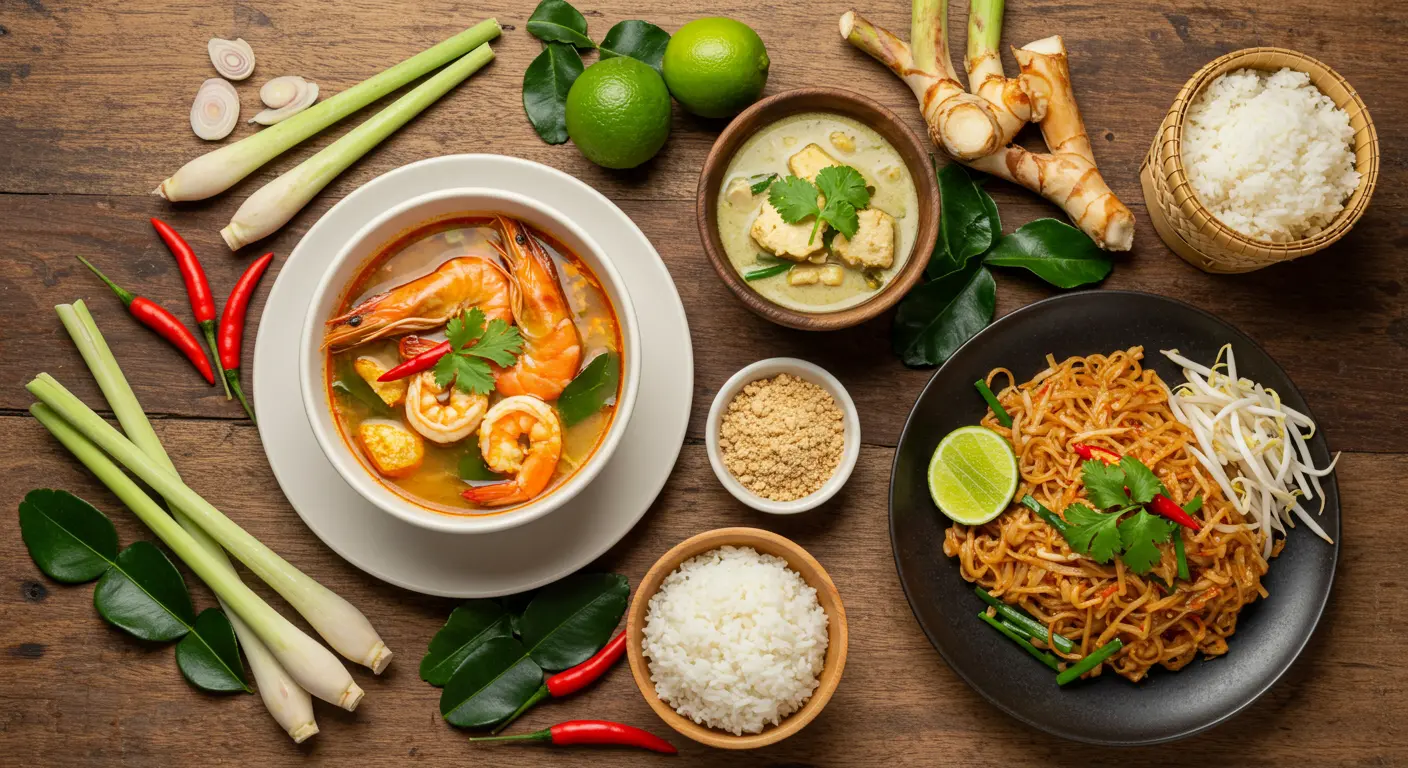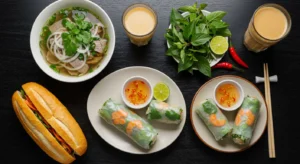Table of Contents
A Beginner’s Guide to Thailand Food: Unlocking the Flavors of a Culinary Paradise
Picture this: You’re sitting at a wobbly plastic table on a bustling Bangkok side street. The air is thick with the sizzle of a wok and an aroma that’s at once spicy, sweet, and utterly irresistible. A plate arrives, a vibrant mosaic of colors—fiery red chilies, emerald green herbs, golden-brown noodles. You take a bite. It’s an explosion. There’s the punch of lime, the gentle heat of chili, the savory depth of fish sauce, and a hint of palm sugar sweetness. This isn’t just eating; it’s an experience. This is Thailand food or Thai food.
If that scene makes your mouth water, you’re in the right place. Thai cuisine can seem intimidating with its complex balance of flavors, but it’s one of the world’s most accessible and rewarding culinary adventures. This guide is your friendly starting point. We’ll demystify the core principles, introduce you to the dishes you absolutely can’t miss, and give you the confidence to dive in, whether you’re planning a trip or just ordering from a local restaurant.
The Heart and Soul of Thai Cuisine: It’s All About Balance
Before we talk about specific dishes, let’s understand the philosophy. Thai food isn’t about overwhelming spice; it’s about harmony. The goal is a perfect dance between five fundamental tastes: salty, sour, sweet, spicy, and bitter (and sometimes, the umami savoriness).
Think of a classic Tom Yum Goong (Spicy Shrimp Soup). The salty comes from fish sauce, the sour from lime juice, the sweet from a touch of sugar, and the spicy from fresh chilies. It’s a symphony in a bowl. This balance is what makes Thai food so moreish—you just can’t stop eating it.
The Pantry Powerhouses: 5 Ingredients You Need to Know
You can’t build a house without a foundation, and you can’t understand Thai food without knowing its core ingredients. These are the flavors that appear again and again.
- Fish Sauce (Nam Pla): This is the salt of Southeast Asia. Made from fermented anchovies, it’s pungent in the bottle but transforms into a deep, savory umami backbone in cooking. Don’t be put off by the smell!
- Shrimp Paste (Kapi): This fermented paste is intensely aromatic (okay, it smells strong) and is essential for curries and dips like Nam Prik. It adds an incredible depth of flavor.
- Thai Chilies (Prik Kee Noo): These small, fiery chilies pack a serious punch. The heat level can vary, so the rule of thumb is: the smaller, the hotter. They’re used fresh, dried, and in pastes.
- Palm Sugar (Nam Tan Pip): This unrefined sugar, made from the sap of palm trees, has a complex caramel-like flavor that’s far more interesting than white sugar. It provides the crucial sweetness that rounds out spicy and sour notes.
- Lemongrass, Galangal, and Kaffir Lime Leaves: This holy trinity of herbs forms the aromatic base of so many Thai soups and curries. Lemongrass adds citrusy zest, galangal (a cousin of ginger) provides a sharp, peppery warmth, and kaffir lime leaves contribute a unique, floral perfume.
Must-Try Thailand Food: A Beginner’s Hit List
Ready to order? Here’s a curated list of iconic dishes that showcase the incredible diversity of Thai cuisine.
The Iconic Noodle Dish: Pad Thai
Let’s start with the world-famous ambassador. Pad Thai is stir-fried rice noodles with eggs, tofu, and your choice of protein (often shrimp or chicken), all tossed in a tangy-sweet sauce made from tamarind, fish sauce, and palm sugar. It’s served with a wedge of lime and crushed peanuts for squeezing and sprinkling over the top. It’s the perfect gateway dish—familiar yet excitingly different.
The Curry Spectrum: From Green to Massaman
Thai curries are a universe unto themselves. They’re not just “spicy”; each color has a distinct personality. The paste is made by pounding fresh ingredients together, which is why the flavors are so vibrant.
- Green Curry (Gaeng Keow Wan): The hottest of the common curries, but don’t let that scare you. Its heat is balanced by the sweetness of coconut milk and fresh green chilies. It’s incredibly aromatic and often cooked with chicken and Thai eggplants.
- Red Curry (Gaeng Phed): A bit milder than green curry, with a rich, rounded flavor from dried red chilies. It’s a versatile base and can be found with everything from duck to bamboo shoots.
- Massaman Curry (Gaeng Massaman): A wonderful example of cultural fusion, influenced by Persian and Indian traders. This curry is mild, rich, and slightly sweet, with warm spices like cinnamon, cardamom, and star anise. It often features potatoes and peanuts, making it a comforting, hearty choice.
The Salad You Won’t Forget: Som Tum
Forget bland lettuce. Som Tum (Green Papaya Salad) is a flavor bomb from Northeastern Thailand (Isan). It’s made by pounding unripe papaya, tomatoes, green beans, chilies, lime, and peanuts in a mortar and pestle. The result is a riot of textures and tastes—incredibly fresh, sour, spicy, and crunchy all at once. It’s a true taste of Thai street food culture. Pro tip: You can ask for it less spicy by saying “mai pet“.
The Comfort Food Champion: Khao Soi
Hailing from Northern Thailand, Khao Soi is a beloved curry noodle soup. It’s a beautiful contrast in textures: egg noodles are served in a rich, creamy, and mildly spicy coconut curry broth, then topped with crispy fried noodles. It’s usually served with a side of pickled mustard greens, red shallots, and a lime wedge to add a bit of tang and crunch. It’s the ultimate comfort food.
Navigating the Thai Dining Experience Like a Pro
Knowing what to order is half the battle. The other half is knowing how to eat it.
- Family-Style is Key: Meals are typically served all at once and shared. Don’t expect a strict starter-main course sequence. A typical meal might include a curry, a stir-fry, a soup, and a plate of rice for everyone.
- The Role of Rice: Jasmine rice (khao suay) is the foundation. It’s meant to be eaten with the other dishes, balancing out the stronger flavors. In the Northeast, sticky rice (khao niao) is more common, eaten with the hands.
- The Condiment Tray: On your table, you’ll often find a tray with four condiments: sugar, chili flakes, fish sauce, and vinegar with chilies. This is your chance to customize the balance of flavors to your exact liking. A little more heat? Add some chili flakes. Need more tang? A splash of vinegar.
A great resource for understanding the depth and regional variations of these dishes is the Michelin Guide’s coverage of Thailand, which highlights everything from street food stalls to fine dining establishments. You can see their picks for Bangkok here.
Frequently Asked Questions (FAQs)
Q: Is all Thai food extremely spicy?
A: Not at all! While spice is a key component, balance is the true goal. Many dishes are mild or can be adjusted. You can always ask for “mai pet” (not spicy) or “pet nit noi” (a little bit spicy). The heat is often customizable with condiments on the table.
Q: What is a must-try dish for a first-timer?
A: Pad Thai is the classic beginner-friendly choice. If you’re feeling a bit more adventurous, Panang Curry is a rich, peanut-based curry that is generally mild and creamy, or Tom Kha Gai (Coconut Chicken Soup), which is aromatic and less spicy than Tom Yum.
Q: I’m a vegetarian/vegan. Is Thailand food-friendly?
A: Yes, but you need to be specific. Fish sauce and shrimp paste are everywhere. The key phrase is “gin jay” (eat vegetarian), which implies Buddhist vegetarianism (no meat, fish, or pungent vegetables like garlic and onion). For vegan, say “mai sai nam pla, mai sai nuea” (no fish sauce, no meat). Many places are accustomed to this request.
Q: What’s the difference between street food and restaurant food in Thailand?
A: Street food is often where you’ll find the most authentic, vibrant, and affordable dishes, cooked by specialists who have perfected one or two recipes. Restaurants offer a wider menu and more comfort (like air conditioning!). Both are essential experiences.
Q: How do I eat sticky rice?
A: It’s a hands-on experience! Take a small lump of rice with your right hand, gently roll it into a ball, and then use it to scoop up your food. It’s fun, tactile, and the proper way to enjoy Isan cuisine.
Your Flavor Adventure Awaits
Thai cuisine is more than just sustenance; it’s a vibrant expression of culture, history, and a deep love for life’s pleasures. It’s about the joy of sharing a meal, the thrill of new flavors, and the perfect balance that keeps you coming back for more.
So, the next time you see a Thai menu or find yourself on a bustling street in Bangkok, remember this guide. Be bold, ask questions, and let your taste buds lead the way. Your culinary passport to one of the world’s greatest food destinations is officially stamped. Now, go eat!




